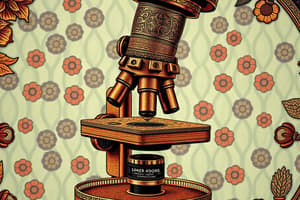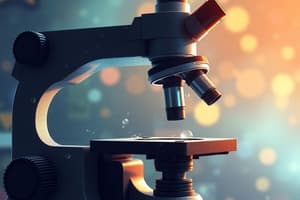Podcast
Questions and Answers
What type of microscope is commonly used in classroom work for general magnification of specimens?
What type of microscope is commonly used in classroom work for general magnification of specimens?
- Scanning Electron microscope
- Compound light microscope (correct)
- Stereomicroscope
- Phase contrast microscope
Which part of the microscope is primarily used for adjusting the focus using the Low Power Objective (LPO)?
Which part of the microscope is primarily used for adjusting the focus using the Low Power Objective (LPO)?
- Coarse adjustment knob (correct)
- Stage clips
- Revolving nosepiece
- Fine adjustment knob
What is the primary function of the diaphragm in a microscope?
What is the primary function of the diaphragm in a microscope?
- To magnify the specimen
- To connect the upper and lower parts
- To hold the slide in place
- To regulate the amount of light (correct)
Which type of microscope uses a focused beam of high-energy electrons for imaging?
Which type of microscope uses a focused beam of high-energy electrons for imaging?
Which part of the microscope supports the entire structure?
Which part of the microscope supports the entire structure?
What is the function of the objective lens in a microscope?
What is the function of the objective lens in a microscope?
What type of objective lens provides the highest level of magnification in a microscope?
What type of objective lens provides the highest level of magnification in a microscope?
Which part of the microscope is responsible for adjusting the light concentration onto the object?
Which part of the microscope is responsible for adjusting the light concentration onto the object?
Flashcards
What is a microscope?
What is a microscope?
A tool used to magnify tiny organisms and structures, allowing scientists to study cells and microorganisms.
What is a compound light microscope?
What is a compound light microscope?
Compound light microscopes use visible light to illuminate and magnify specimens. These are often used in classrooms.
What is a stereomicroscope (dissecting microscope)?
What is a stereomicroscope (dissecting microscope)?
Stereomicroscopes are used for dissecting small specimens, providing a 3D view with lower magnification than compound light microscopes.
What is a phase contrast microscope?
What is a phase contrast microscope?
Signup and view all the flashcards
What is a transmission electron microscope (TEM)?
What is a transmission electron microscope (TEM)?
Signup and view all the flashcards
What is a scanning electron microscope (SEM)?
What is a scanning electron microscope (SEM)?
Signup and view all the flashcards
What is the base of a microscope?
What is the base of a microscope?
Signup and view all the flashcards
What is the arm of a microscope?
What is the arm of a microscope?
Signup and view all the flashcards
Study Notes
Importance of Microscopes
- Microscopes are essential tools for studying living things.
- Scientists use them to examine cells and various microscopic organisms.
Types of Microscopes
- Compound Light Microscope: Commonly used in classrooms. It uses light to magnify specimens. Common magnifications include 40x, 100x, and 400x.
- Stereomicroscope (Dissecting Microscope): Used for dissecting small specimens. It has lower magnification than a compound light microscope.
- Phase Contrast Microscope: Employs light refraction to create contrast, improving visibility of specimens compared to a compound light microscope, which uses direct light.
- Transmission Electron Microscope (TEM): Uses electrons instead of light, enabling 100,000x magnification.
- Scanning Electron Microscope (SEM): Utilizes a focused beam of high-energy electrons to generate signals from the surface of solid specimens. Magnification is greater than 500,000x.
Microscope Parts
- Mechanical Parts:
- Base: Supports the entire microscope.
- Arm: Used to hold and carry the microscope.
- Body Tube: Connects the upper and lower parts of the microscope.
- Revolving Nosepiece: Used to switch between different objective lenses.
- Coarse Adjustment Knob: Used for initial focusing, especially with low-power objectives.
- Fine Adjustment Knob: Used for precise focusing, primarily with high-power objectives.
- Stage: Platform where the specimen slide is placed.
- Stage Clips: Used to hold the slide in place.
- Optical Parts:
- Mirror/Light Source: Directs light through the specimen.
- Diaphragm: Controls the amount of light reaching the specimen.
- Condenser: Concentrates light onto the specimen.
- Low Power Objective (LPO): Magnifies the specimen 10-15 times, offering a general view.
- High Power Objective (HPO): Provides 40-45x magnification.
- Oil Immersion Objective: Offers 100x magnification and uses special oil for enhanced resolution.
- Ocular/Eyepiece: The part through which the viewer looks to see the magnified image.
Studying That Suits You
Use AI to generate personalized quizzes and flashcards to suit your learning preferences.





